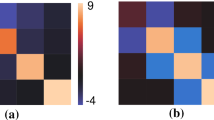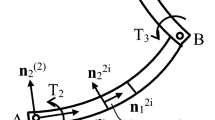Abstract
The isotropic compliance property is examined in the Special Euclidean Group SE(3) in the case of redundant manipulators. The redundancy problem is solved by means of the QR decomposition of the transposed Jacobian matrix, and the compliance property is achieved by means of active stiffness regulation. Thanks to the defined control matrices, the control system realizes the isotropy condition. The local optimization of the joint torques is discussed. In particular, the joint control torques work is minimized obtaining an analytic solution through a Lyapunov equation. The proposed approach is applied to a 7R and to a 9R serial manipulator, and verified by means of multibody dynamics simulations.











Similar content being viewed by others
References
Vinogradov, I.B., Kobrinski, A.E., Stepanenko, Y.E., Tives, L.T.: Details of kinematics of manipulators with the method of volumes. Mekhanika Mashin 1(5), 5–16 (1971)
Klein, C.A., Blaho, B.E.: Dexterity measures for the design and control of kinematically redundant manipulators. Int. J. Robot. Res. 6(2), 72 (1987)
Kumar, A., Waldron, K.J.: The workspace of a mechanical manipulator. J. Mech. Des. 103, 665–672 (1981)
Park, F.C., Brockett, R.W.: Kinematic dexterity of robotic mechanisms. Int. J. Robot. Res. 13(1), 1–15 (1994)
Yang, D.C., Lai, Z.C.: On the conditioning of robotic manipulators - service angle. ASME J. Mech. Transm. Autom. Des. 107(5), 262–270 (1985)
Angeles, J., López-Cajún, C.S.: Kinematic isotropy and the conditioning index of serial robotic manipulators. Int. J. Robot. Res. 11(6), 560–571 (1992)
Yoshikawa, T.: Manipulability of robotic mechanisms. Int. J. Robot. Res. 4(2), 3–9 (1985)
Salisbury, J.K., Craig, J.J.: Articulated hands: force control and kinematic issues. Int. J. Robot. Res. 1(1), 4–17 (1982)
Merlet, J.P.: Jacobian, manipulability, condition number, and accuracy of parallel robots. J. Mech. Des. 128(1), 199–206 (2006)
Bandyopadhyay, S., Ghosal, A.: An algebraic formulation of kinematic isotropy and design of isotropic 6–6 stewart platform manipulators. Mech. Mach. Theory 43(5), 591–616 (2008)
Legnani, G., Tosi, D., Fassi, I., Giberti, H., Cinquemani, S.: The point of isotropy and other properties of serial and parallel manipulators. Mech. Mach. Theory 45(10), 1407–1423 (2010)
Belfiore, N., Di Giamberardino, P., Rudas, I., Verotti, M.: Isotropy in any RR planar dyad under active joint stiffness regulation. Int. J. Mech. Control 12(1), 75–81 (2011)
Belfiore, N.P., Verotti, M., Di Giamberardino, P., Rudas, I.J.: Active joint stiffness regulation to achieve isotropic compliance in the Euclidean space. J. Mech. Robot. 4(4), 041010 (2012)
Angeles, J.: Fundamentals of Robotic Mechanical Systems: Theory, Methods, and Algorithms, vol. 124. Springer, New York (2013)
Verotti, M., Belfiore, N.P.: Isotropic compliance in E(3): feasibility and workspace mapping. J. Mech. Robot. 8(6), 061005 (2016)
Verotti, M., Masarati, P., Morandini, M., Belfiore, N.: Isotropic compliance in the Special Euclidean Group SE(3). Mech. Mach. Theory 98, 263–281 (2016)
Calanca, A., Muradore, R., Fiorini, P.: A review of algorithms for compliant control of stiff and fixed-compliance robots. IEEE/ASME Trans. Mechatron. 21(2), 613–624 (2016)
Firouzeh, A., Paik, J.: Grasp mode and compliance control of an underactuated origami gripper using adjustable stiffness joints. IEEE/ASME Trans. Mechatron. 22(5), 2165–2173 (2017)
Verotti, M., Dochshanov, A., Belfiore, N.: Compliance synthesis of CSFH MEMS-based microgrippers. J. Mech. Des., Trans. ASME 139(2), 022301 (2017)
Nasiri, R., Khoramshahi, M., Shushtari, M., Ahmadabadi, M.: Adaptation in variable parallel compliance: towards energy efficiency in cyclic tasks. IEEE/ASME Trans. Mechatron. 22(2), 1059–1070 (2017)
Lee, G., Park, S., Lee, D., Park, F., Jeong, J., Kim, J.: Minimizing energy consumption of parallel mechanisms via redundant actuation. IEEE/ASME Trans. Mechatron. 20(6), 2805–2812 (2015)
Colbaugh, R., Seraji, H., Glass, K.: Obstacle avoidance for redundant robots using configuration control. J. Field Robot. 6(6), 721–744 (1989)
Duguleana, M., Barbuceanu, F.G., Teirelbar, A., Mogan, G.: Obstacle avoidance of redundant manipulators using neural networks based reinforcement learning. Robot. Comput.-Integr. Manuf. 28(2), 132–146 (2012)
Menon, M.S., Ravi, V., Ghosal, A.: Trajectory planning and obstacle avoidance for hyper-redundant serial robots. J. Mech. Robot. 9(4), 041010 (2017)
Zhang, Z., Zheng, L., Yu, J., Li, Y., Yu, Z.: Three recurrent neural networks and three numerical methods for solving a repetitive motion planning scheme of redundant robot manipulators. IEEE/ASME Trans. Mechatron. 22(3), 1423–1434 (2017)
Antonelli, G., Chiaverini, S., Fusco, G.: A new on-line algorithm for inverse kinematics of robot manipulators ensuring path tracking capability under joint limits. IEEE Trans. Robot. Autom. 19(1), 162–167 (2003)
Xiang, J., Zhong, C., Wei, W.: General-weighted least-norm control for redundant manipulators. IEEE Trans. Robot. 26(4), 660–669 (2010)
Flacco, F., De Luca, A., Khatib, O.: Control of redundant robots under hard joint constraints: saturation in the null space. IEEE Trans. Robot. 31(3), 637–654 (2015)
Chiaverini, S.: Singularity-robust task-priority redundancy resolution for real-time kinematic control of robot manipulators. IEEE Trans. Robot. Autom. 13(3), 398–410 (1997)
Fang, J., Mei, T., Zhao, J., Li, T.: A dual-mode online optimization method for trajectory tracking of redundant manipulators. Ind. Robot: An International Journal 43(2), 241–252 (2016)
Vukobratovic, M., Kircanski, M.: A dynamic approach to nominal trajectory synthesis for redundant manipulators. IEEE Trans. Syst. Man Cybern. 4, 580–586 (1984)
Hirakawa, A.R., Kawamura, A.: Trajectory planning of redundant manipulators for minimum energy consumption without matrix inversion. In: Robotics and Automation, 1997. IEEE International Conference on Proceedings, vol. 3, pp. 2415–2420. IEEE, Albuquerque, NM, USA (1997)
Halevi, Y., Carpanzano, E., Montalbano, G.: Minimum energy control of redundant linear manipulators. J. Dyn. Syst. Meas. Control 136(5), 051016 (2014)
Hollerbach, J., Suh, K.: Redundancy resolution of manipulators through torque optimization. IEEE J. Robot. Autom. 3(4), 308–316 (1987)
Kang, H.J., Freeman, R.A.: Null space damping method for local joint torque optimization of redundant manipulators. J. Field Robot. 10(2), 249–270 (1993)
Chung, C., Lee, B.H., Kim, M., Lee, C.: Torque optimizing control with singularity-robustness for kinematically redundant robots. J. Intell. Robot. Syst. 28(3), 231–258 (2000)
Fang, J., Zhao, J., Mei, T., Chen, J.: Online optimization scheme with dual-mode controller for redundancy-resolution with torque constraints. Robot. Comput.-Integr. Manuf. 40, 44–54 (2016)
Shin, H., Lee, S., Jeong, J., Kim, J.: Antagonistic stiffness optimization of redundantly actuated parallel manipulators in a predefined workspace. IEEE/ASME Trans. Mechatron. 18(3), 1161–1169 (2013)
Nemec, B., Zlajpah, L.: Force control of redundant robots in unstructured environment. IEEE Trans. Ind. Electron. 49(1), 233–240 (2002)
Nenchev, D., Okawa, R., Sone, H.: Task-space dynamics and motion/force control of fixed-base manipulators under reaction null-space-based redundancy resolution. Robotica 34(12), 2860–2877 (2016)
Ajoudani, A., Tsagarakis, N., Bicchi, A.: Choosing poses for force and stiffness control. IEEE Trans. Robot. 33(6), 1483–1490 (2017)
Masarati, P.: Computed torque control of redundant manipulators using general-purpose software in real-time. Multibody Syst. Dyn. 32(4), 403–428 (2014)
Lin, Z., Patel, R.V., Balafoutis, C.A.: Impact reduction for redundant manipulators using augmented impedance control. J. Field Robot. 12(5), 301–313 (1995)
Kim, K.H., Park, I.J., Choi, J.H., Rhim, S.: Evaluation of head-collision safety of a 7-dof manipulator according to posture variation. Multibody Syst. Dyn. 37(1), 95–105 (2016)
Siciliano, B.: Kinematic control of redundant robot manipulators: a tutorial. J. Intell. Robot. Syst. 3(3), 201–212 (1990)
Zhang, Z., Chen, S., Li, S.: Compatible convex-nonconvex constrained qp-based dual neural networks for motion planning of redundant robot manipulators. IEEE Trans. Control Syst. Technol. 99, 1–9 (2018)
Whitney, D.E.: Resolved motion rate control of manipulators and human prostheses. IEEE Trans. Man-Mach. Syst. 10(2), 47–53 (1969)
Wampler, C.W.: Manipulator inverse kinematic solutions based on vector formulations and damped least-squares methods. IEEE Trans. Syst. Man Cybern. 16(1), 93–101 (1986)
Sciavicco, L., Siciliano, B.: A solution algorithm to the inverse kinematic problem for redundant manipulators. IEEE J. Robot. Autom. 4(4), 403–410 (1988)
Patel, R.V., Shadpey, F.: Control of Redundant Robot Manipulators: Theory and Experiments, vol. 316. Springer, Berlin (2005)
Chiacchio, P., Chiaverini, S., Sciavicco, L., Siciliano, B.: Closed-loop inverse kinematics schemes for constrained redundant manipulators with task space augmentation and task priority strategy. Int. J. Robot. Res. 10(4), 410–425 (1991)
Wampler, C.: Inverse kinematic functions for redundant manipulators. In: 1987 IEEE International Conference on Robotics and Automation. Proceedings, vol. 4, pp. 610–617. IEEE, Raleigh, NC, USA (1987)
Zhang, Z., Fu, T., Yan, Z., Jin, L., Xiao, L., Sun, Y., Yu, Z., Li, Y.: A varying-parameter convergent-differential neural network for solving joint-angular-drift problems of redundant robot manipulators. IEEE/ASME Trans. Mechatron. 23(2), 679–689 (2018)
Zhang, Z., Lin, Y., Li, S., Li, Y., Yu, Z., Luo, Y.: Tricriteria optimization-coordination motion of dual-redundant-robot manipulators for complex path planning. IEEE Trans. Control Syst. Technol. 26(4), 1345–1357 (2018)
Merlini, T., Morandini, M.: The helicoidal modeling in computational finite elasticity. Part I: variational formulation. Int. J. Solids Struct. 41(18–19), 5351–5381 (2004)
Golub, G.H., Van Loan, C.F.: Matrix Computations. forth JHU Press, Baltimore (2013)
Masarati, P., Morandini, M., Mantegazza, P.: An efficient formulation for general-purpose multibody/multiphysics analysis. J. Comput. Nonlinear Dyn. 9(4), 041001 (2014)
Author information
Authors and Affiliations
Corresponding author
Additional information
Publisher’s Note
Springer Nature remains neutral with regard to jurisdictional claims in published maps and institutional affiliations.
Appendix
Appendix
The first posture () end-effector response, in the case of a force applied along the \(y\) direction with and without control action, is reported in Fig. 12. Analogously, the cases regarding the force on the \(z\) direction, the moment about the \(x\) direction, and the moment about the \(z\) direction are reported in Fig. 13, Fig. 14, and Fig. 15, respectively. The correspondent end-effector responses for the second case () are reported in Fig. 16, Fig. 17, Fig. 18 and Fig. 19.
Rights and permissions
About this article
Cite this article
Verotti, M., Masarati, P., Morandini, M. et al. Active isotropic compliance in redundant manipulators. Multibody Syst Dyn 49, 421–445 (2020). https://doi.org/10.1007/s11044-020-09724-2
Received:
Accepted:
Published:
Issue Date:
DOI: https://doi.org/10.1007/s11044-020-09724-2












